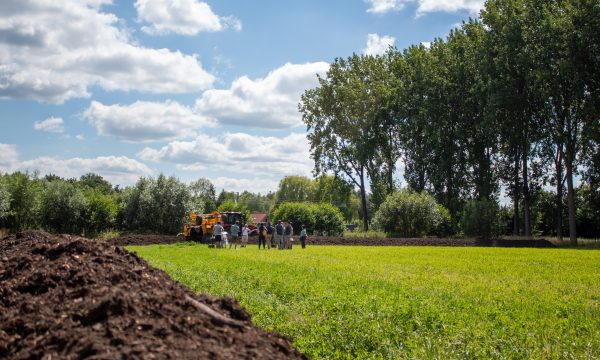Press release In-depth knowledge of soil pathogens in greenhouse soil offers opportunities for IPM

In the intensive greenhouse cultivation of butterhead lettuce, the correct identification of soil pathogens and newly acquired insights into their potential to damage crops can help the lettuce plants to grow well but with fewer chemical treatments. That is the hope-giving conclusion of the ILVO-UGENT doctorate that Jolien Claerbout recently defended.
Integrated pest management (IPM)
Because the number and type of chemical treatments in the sector is rapidly dropping, lettuce growers are looking for alternative ways to control the pathogens in the soil. In a number of professional practice greenhouses Claerbout studied both the presence of soil-bound plant pathogens (nematodes, fungi and pseudo-fungi) and the effect of all kinds of control methods. "Techniques such as crop rotation, set-aside, soil disinfection and integrated control can work if you know exactly what amounts of nematodes and/or which fungi are present. Current control measures are insufficiently effective against the relatively new, aggressive wilting fungus Fusarium oxysporum f. sp. lactucae. Application of hygiene measures is essential for this new pathogen," says Jolien Claerbout.
Current control measures are insufficiently effective against the relatively new, aggressive wilting fungus Fusarium oxysporum f. sp. lactucae.
Intensive lettuce cultivation and pesticides
Butterhead lettuce is an important vegetable on the Belgian market with a turnover of € 27.1 million in 2018. Belgian production is characterized by high-quality, heavy heads of lettuce. Lettuce is mainly grown in soil in greenhouses in an intensive production system with up to five harvests per year. However, this intensive production leads to an increased incidence of disease of various soil-bound plant pathogens, including fungi, pseudo-fungi and nematodes. The most important nematodes are the root-lesion nematode Pratylenchus penetrans and the pin nematode Paratylenchus sp. These nematodes damage the root system and reduce the growth of the crop. Rotting of the oldest leaves, called “smet” in Dutch, is an important disease in Belgian lettuce. The symptoms are caused by the fungi Rhizoctonia solani, Botrytis cinerea and Sclerotinia spp. and the pseudo-fungal Pythium spp. These pathogens are currently mainly controlled by chemical soil disinfection and sprays. Since 2015, Fusarium oxysporum f. sp. lactucae, which causes severe wilting, has also been observed in several greenhouses in Belgium. Effective control measures are currently not available for this fungus, which puts the current production system under pressure.
Diseases in greenhouse soils are thus largely controlled using chemical methods, but European directives require the sustainable use of such treatments, and growers must rely on integrated pest management. But this requires knowledge about the identity and characteristics of the pathogens, about the effectiveness of disease management strategies and about lettuce cultivation itself. In her doctoral research Jolien Claerbout therefore focused on the spread of nematodes, pseudo-fungi and fungi, studied the advantages and disadvantages of an intensive lettuce production system, and carried out strength-weakness analyses on pesticides and biopesticides.
Crop rotation, black fallow soil and disinfection keep nematodes in check
Commercial greenhouses are often densely populated with soil nematodes, resulting in damage to the crop. For the study of lettuce cultivation, populations of root lesion nematode and pin nematode were monitored for at least one year by regularly sampling the same four sites of 1 m² at 0-30 cm and 30-60 cm depth in Belgian commercial greenhouses.
For root lesion nematodes (P. penetrans) it was established that
- Soil disinfection strongly suppresses nematodes, but that a part survives deeper into the soil
- rotation with leek slightly reduced the population, while a slight increase was observed after lettuce
- the weight of the crop (for a summer and autumn variety) decreased at densities above 700 and 3800 nematodes per 100 ml of soil. Root damage was already visible from 50 and 200 nematodes per 100 ml of soil (summer and autumn).
It was established for pin nematodes (Paratylenchus sp.) that
- it is a hitherto undescribed species (based on microscopic and genetic characteristics).
- high densities were observed in winter and spring, with up to more than 20,000 nematodes per 100 ml of soil
- soil disinfection strongly suppresses nematodes, but that part survives deeper into the soil. After steaming with underpressure no nematodes were found, with long-lasting results (more than 9 months).
- two months of black fallow in the spring resulted in 50 to 76% fewer pin nematodes
- the population increased after lettuce by a factor of 1 to 2, while for lamb's lettuce, parsley and rocket the population decreased.
- these nematodes did not affect the heads of lettuce in pot trials, even at densities of up to 35,000 nematodes per 100 ml of soil. However, the roots were affected from 400 nematodes per 100 ml of soil.
These results show that an increase in nematode population can be prevented by control measures such as crop rotation, soil disinfection or black fallow. The extent and type of damage strongly depends on the type of nematode and the numbers found.
Keeping the lettuce healthy: from standard spraying schemes to tailor-made treatments
Fungi and pseudo-fungi, such as R. solani, Sclerotinia spp., B. cinerea and Pythium spp., cause the so-called 'smet' in lettuce cultivation. In order to eliminate them, lettuce growers often use standard year-round spraying schedules directed against all (pseudo)fungi. In order to investigate whether the use of fungicides could be reduced by controlling only the active fungus, a trial was set up in which lettuce was grown continuously without any fungicide application in three greenhouses of the partner practical research centers (Inagro, PCG, PSKW). The pathogens causing the smet were identified as soon as symptoms were visible.
The prevalence of smet pathogens was found to be mainly greenhouse specific and the different smet pathogens were active all year round. They did appear under different circumstances, however. R. solani AG4-HGI and Pythium ultimum appeared to be active at higher temperatures and R. solani AG2-1, AG-BI, AG1-IB and Pythium sylvaticum at lower temperatures. These results show that the spray schedule for fungicides needs to be adapted to the greenhouse pathogens rather than limiting the applications to a certain period of time.
The fungus Fusarium oxysporum f. sp. lactucae is a maverick: this threat to lettuce is new (since 2015) and there are currently no control measures available. Jolien Claerbout's research provides more clarity about the origin of the disease, thanks to genetic analysis. She analyzed 78 Belgian Fusarium isolates and concluded that they belong to two different groups (physios). Tests of the Fusarium pathogenicity show that the infection method is important when differences in aggressiveness between isolates are investigated: mixing chlamydospores in the substrate shows differences, while this is not the case when the roots are dipped in a trace solution of microconidia.
Towards less intensive lettuce cultivation?
Intensive lettuce production is common practice, but it leads to a higher incidence of soil-bound plant diseases. Nevertheless, this practice is still widely used, mainly because of its excellent cost efficiency. But can it be done differently? In her doctoral research she therefore discusses alternatives such as hydroponics or a system-based approach to soil-bound pathogens. Jolien Claerbout also carried out a strength-weakness analysis of pesticides and microbial pesticides together with the project partners. The latter are very promising, because they have a good eco-toxic profile, leave less residues on the head lettuce, show only slow to no resistance development, increase soil resilience and possibly have a long-term effect. The main stumbling block for a more general application is the need to increase effectiveness (through research) and improve application so that food safety and lettuce quality can be guaranteed.
"Disease control in the intensive lettuce production system is a complex challenge. It has become even more difficult with the advent of Fusarium. As a result, growers are forced to review and adapt the production system themselves. That is why our kind of research is becoming so important: namely combined effect studies of cultivation interventions and of (still) available resources, and monitoring and identification of advancing pathogens," concludes Jolien Claerbout.
That is why our kind of research is becoming so important: namely combined effect studies of cultivation interventions and of (still) available resources, and monitoring and identification of advancing pathogens


